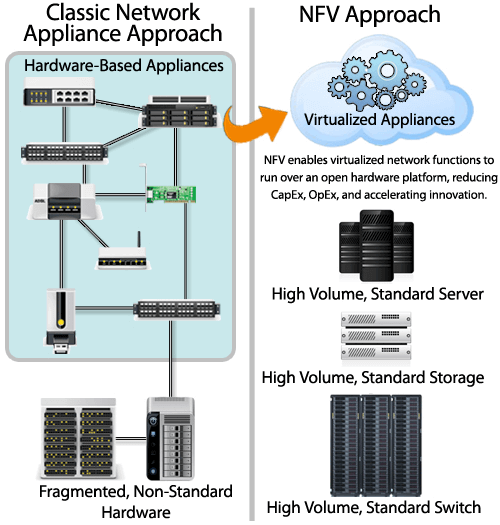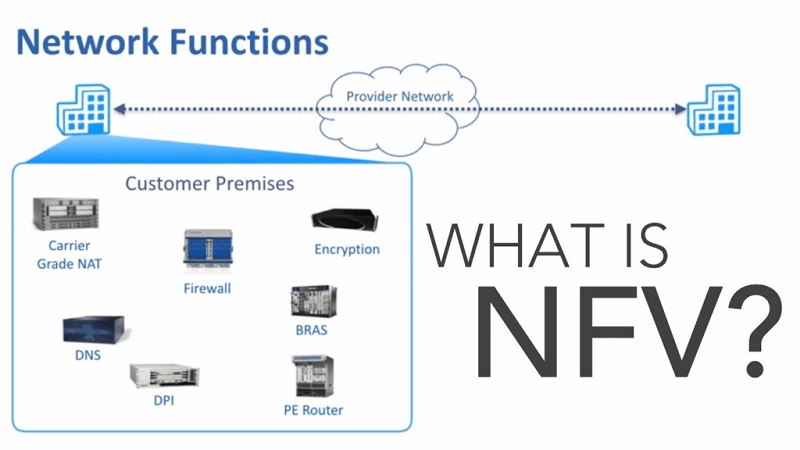Network Function Virtualization (NFV) is a concept belonging to the network architecture that makes use of IT virtualization technologies. It is used for the virtualization of entire classes of the network nodes and turns them into the building material that will contribute together to form communication services. Although the network function virtualization is greatly dependent on the traditional virtualization of the server, it differs greatly. If we consider a virtualized network function, it can consist of multiple virtual machines that act as containers to run various software and processes. We can deploy a virtual session border controller for protecting any network without the need of incurring the cost or complexity that is typical of these processes. There is also no hassle of going through the installation of physical network protection units.
FRAMEWORK OF NFV:
The three main components that constitute the framework of the network function virtualization are:
- Virtualized Network Function (VFN): Itis the network functions’ implementation in software that is suitable for being deployed in the Network Function Virtualization Infrastructure (NFVI)
- Network Function Virtualization Infrastructure(NFVI): It is the summation of all the components, both hardware, and software, that constitutes the environment for deploying the virtual network functions. The infrastructure can span different locations. The network that connects these different locations can be considered to be a part of the network function virtualization infrastructure.
- Network Function Virtualization Management and Orchestration Architectural Framework (NFV-MANO Architectural Framework): It comprises the functional blocks with the data repositories that they use and also the reference point and interfaces through which information is exchanged. This is done for orchestrating and managing the NFVI and VNF.

The NFV platform acts as the building block for NFVI and NFV-MANO. As the building block, it can be easily inferred that the NFV platform consists of processing and storage resources in both physical and virtual forms. For providing effective security and managing the platform components or even recovering from failures, carrier-grade features are implemented by the NFV platform. These are very important features that are required for a public carrier network.
BENEFITS OF Network Function Virtualization:
With the rise of network function virtualization, it has been very promising in easing the burden granting flexibility to the service provider for moving the network functions to generic servers from the dedicated appliances. Some of the common benefits of network function virtualization are as below:
- Security: In networking, security has always been a very big challenge. The network function virtualization enables the network operators the capability of managing and provisioning the network while the customers are allowed to run their personal virtual space and firewall securely within the network itself.
- Cost: Network functions that are implemented in the network are software-based so moving them to various locations is very easy. There would be no need to deploy any kind of hard assets but it can be easily done by moving inexpensive and high volume server infrastructure including virtual machines running with them.
- Flexibility: The network operators who are looking for deploying the new services quickly, need a network that is much more flexible and adaptable. We all know that the NFV is one that can not only be installed quickly and easily but can also be easily provisioned.
- Scalability: The NFV allows the network operators to adapt to the users’ needs very fast and provide them with new services. This allows the operator to scale the network architecture across various services and they are not limited by what a single box can do.
INDUSTRY IMPACT OF NFV:
Since the NFB was in its infancy, it has been considered a very effective standard. There exist numerous applications for the NFV and some of them are virtualization of mobile base stations, content delivery networks (CDN), or even the platform as a service (PaaS). Apart from these usual applications, the potential benefits of NFV are considered to be of very much significance.
For the reduction of capital expenditure and operational expenditure and also the service and introduction time of any product in the market, the virtualization that is done on the network functions before deploying on general-purpose hardware, which is standardized, has proven to be very effective. The network function virtualization is that many of the vendors for such network devices have shown their support for the NFV. Many big software providers have also shown their support by providing platforms that are used by the network equipment makers for building any NFV product.

For achieving things such as high availability, scalability, effective network management capabilities, and great performance, the vendors of network equipment are pushing the IT virtualization Technology for incorporating the required attributes that are carrier-grade. All these efforts are for realizing the benefits of virtualization that are anticipated by everyone. But we have to keep in mind that the carrier trade features must be implemented very efficiently for minimizing the total cost of ownership or TCO. The efficient use of redundant resources must be done in such a way that it does not compromise is the performance predictability.
The key factor in achieving an efficient carrier-grade NFV solution is the NFV platform. The platform is a software platform that runs on the industry-standard multi-core hardware that is made to incorporate carrier-grade features by using open-source software. As the traditional function of dedicated equipment is being replaced by the VNF, the availability is changing from being equipment-based to service-based. The virtualization-based change the way availability was specified at a point in time. The way it is measured and achieved has also changed.
